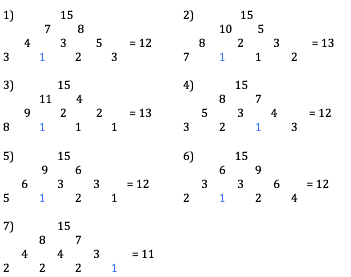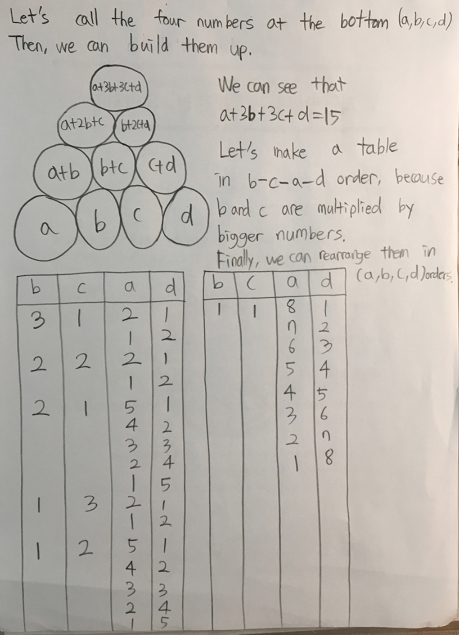Copyright © University of Cambridge. All rights reserved.
'Build it Up' printed from https://nrich.maths.org/
Show menu
We had a very large number of solutions come in for this challenge. Here are a selection for you to consider.
Primary 6 at Victoria Primary School in Scotland sent in this very thorough solution
Firstly, we looked at the 4 numbers at the bottom and tried to work out how to get to 15. As a class we agreed that this would take too long for us to try and work out all the 4 digit numbers. So next we worked out a system...
We started at the top and worked out all the 2 digit numbers that make 15 which were
14 + 1; 13 + 2; 12 + 3; 11 + 4; 10 + 5; 9 + 6; 8 + 7; 7 + 8; 6 + 9; 5 + 10; 4 + 11; 3 + 12; 1+ 14;
Then we looked at next row down and worked out that we couldn't have 1 + 14 and 14 + 1 because we we couldn't use 0 so nothing adds up to 0. We took a pair of numbers each and worked out some of the group of 3 numbers which were:
| making 15 | making | the | two | totals | |||
| 9 + 6 | 8,1,5 | 7,2,3 | 6,3,2 | 5,4,3 | 4,5,1 | ||
| 5 + 10 | 4,1,9 | 3,2,8 | 2,3,7 | 1,4,6 | |||
| 12 + 3 | 11,1,2 | 10,2,1 | |||||
| 6 + 9 | 3,3,6 | 2,4,5 | 1,5,4 | 4,2,7 | |||
| 11 + 4 | 10,1,3 | 9,2,2, | 8,3,1 | ||||
| 8 + 7 | 7,1,6 | 6,2,5 | 5,3,4 | 4,4,3 | 3,5,2 | 2,6,1 | |
| 7 + 8 | 3,4,5 | 5,2,6 | 6,1,7 | ||||
| 10 + 5 | 9,1,4 | 8,2,3 | 7,3,2 | 6,4,1 | |||
| 3 + 12 | 1,2,10 | 2,1,11 | |||||
| 13 + 2 | 12,1,1 | ||||||
| 4 + 11 | 3,1,10 | 2,2,9 | 1,3,8 |
And from that we were able to do the exact same to work out the four
numbers which are:
2221; 8111; 4122; 4211; 5212; 3211; 5211; 4122; 7112; 5114; 3213; 3123; 7112; 2131; 7112; 7223; 5211; 2214; 2311; 8231; 1312; 6113; 1127; 1118; 4212;
We really enjoyed the challenge and our (something? brains? hands? minds ?) hurts after it but in a good way.
We really needed to keep a growth mindset.
This has been explained very well but now have a look at the ones I've put in italics (and underlined) what do you think about them?
We also had a number of solutions sent in from Peak School in Hong Kong
Alyssa wrote:
I found that all of my solutions always had a 1 in the bottom row, and the
total of all the numbers in the bottom row was always an odd number.
Victoria K & F wrote:
These are our solutions:

Rules:
There has to always be a 1 in the bottom row.
In the bottom row will always be a number repeated twice.
The bottom row must equal an odd number.
The second to bottom row must equal 11, 12 or 13.
There must be a combination of odd and even numbers in every row.
Mathias wrote:
I found out 9 different ways to get 15 using different numbers.

Sophie and Dorika wrote:
We think that the bottom line has to add up to an odd number.
We also found out that there has to be a one in in the bottom row.
The middle line can't have a one in it.
The second to bottom row will equal to 11, 12, 13.
On the bottom row a number will always be repeated twice or three times.
There are only 4 pairs of numbers that can be used in the second row.

Extension:
We combined your idea and we did our own version using decimal points
15
9 6
6 3 3
4 2 1 2
2.5 1.5 .5 .5 1.5
1.25 1.25 .25 .25 .25 1.25
.125 1.125 .125 .125 .125 .125 1.125
Chloé, Holly and Anna wrote:
We found these solutions by starting from the top row and working our way
to the bottom:

We found some rules after finding the solutions:
-The bottom row must equal an odd number (7, 9, 11)
-The second to bottom row equal 11,12 or 13
-On the bottom row there will always be a number repeated twice
-There has to be be one in the bottom row
Thanks for reading!
Jihun from Dong Sung Elementary School in South Korea sent in the workthat had been done:

Well done all of you. It was very interesting reading about your methods and the things that you found out that had to be. Keep up your good work.